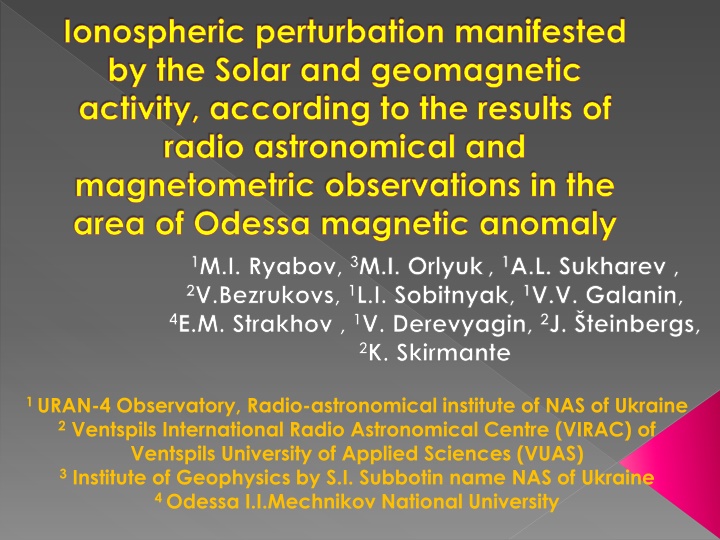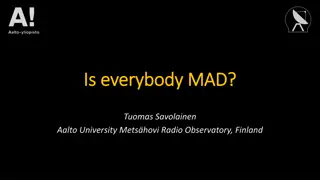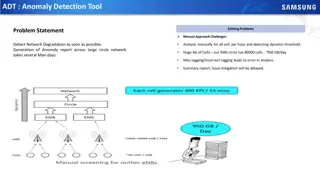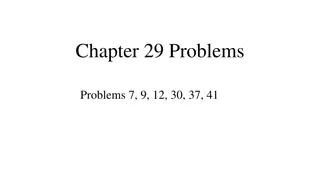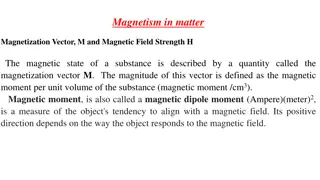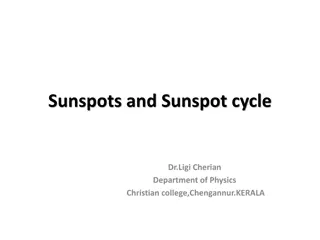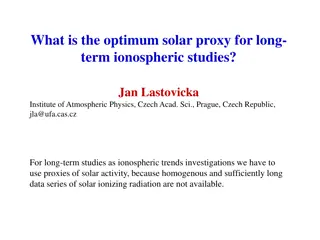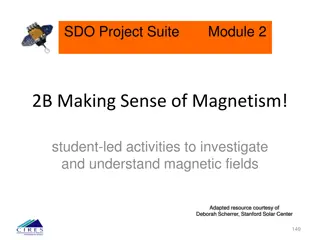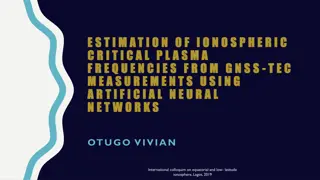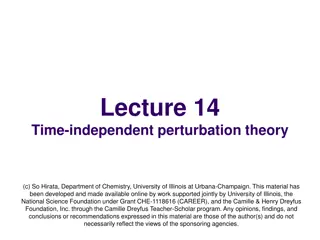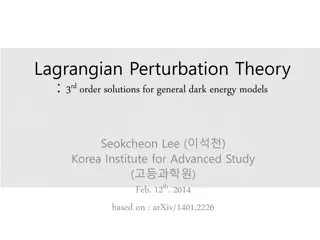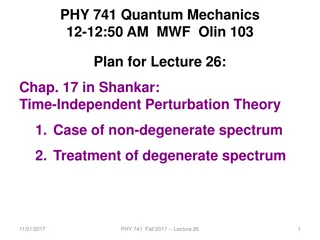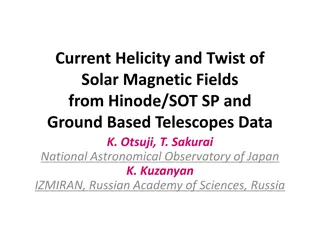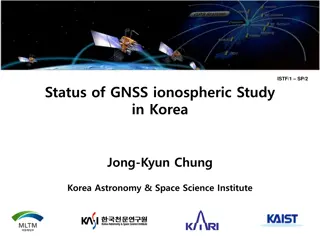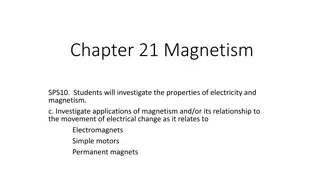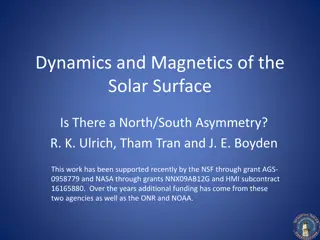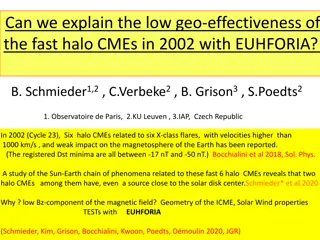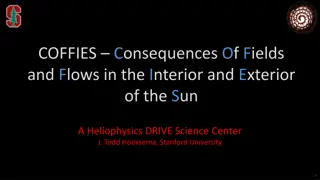Study on Ionospheric Perturbation Due to Solar and Geomagnetic Activity in Odessa Magnetic Anomaly
Research conducted in the area of the Odessa magnetic anomaly investigates ionospheric perturbations caused by solar and geomagnetic activity. The study utilizes radio astronomical and magnetometric observations from various observatories, highlighting the significance of the geomagnetic anomaly near Odessa and its implications on studying magnetic storms. Data from the Odessa Astronomical Observatory and the village of Stepanovka are compared, revealing subtle differences in magnetic variations. The findings contribute to understanding the complex interplay between solar, geomagnetic, and ionospheric phenomena in the region.
Download Presentation

Please find below an Image/Link to download the presentation.
The content on the website is provided AS IS for your information and personal use only. It may not be sold, licensed, or shared on other websites without obtaining consent from the author.If you encounter any issues during the download, it is possible that the publisher has removed the file from their server.
You are allowed to download the files provided on this website for personal or commercial use, subject to the condition that they are used lawfully. All files are the property of their respective owners.
The content on the website is provided AS IS for your information and personal use only. It may not be sold, licensed, or shared on other websites without obtaining consent from the author.
E N D
Presentation Transcript
Ionospheric perturbation manifested by the Solar and geomagnetic activity, according to the results of radio astronomical and magnetometric observations in the area of Odessa magnetic anomaly 1M.I. Ryabov, 3M.I. Orlyuk, 1A.L. Sukharev , 2V.Bezrukovs, 1L.I. Sobitnyak, 1V.V. Galanin, 4E.M. Strakhov , 1V. Derevyagin, 2J. teinbergs, 2K. Skirmante 1 URAN-4 Observatory, Radio-astronomical institute of NAS of Ukraine 2Ventspils International Radio Astronomical Centre (VIRAC) of Ventspils University of Applied Sciences (VUAS) 3Institute of Geophysics by S.I. Subbotin name NAS of Ukraine 4 Odessa I.I.Mechnikov National University
The geomagnetic anomaly, located near the city of Odessa, was discovered and described in 1892 by Professor S. Popruzhenko. This is one of the largest magnetic anomalies in the southern region of Ukraine. The anomalous field tends to increase with time, which has been observed for many years. A unique feature for studying the effects of magnetic storms is the location in the region of the anomaly of the low-frequency radio telescope URAN-4 (operating frequency range 10 - 30 MHz). This makes it possible to study the interrelation between fast geomagnetic variations, and ionospheric radio scintillations of powerful cosmic radio sources.
The work used data from two places - the Odessa Astronomical Observatory, which is located near the center of the magnetic anomaly, and the magnetic observatory in the village of Stepanovka, on the edge of the magnetic anomaly. Precision fluxgate magnetometer LEMI-008 is located in the cellar of the building of Odessa Astronomical Observatory. The observatory is located in a quiet park, far from the technological noise and interference from a big city. Odessa Astronomical Observatory, Ukraine
The data from magnetic observatory in Stepanovka was used by us as reference records of magnetic storms. The magnetometers in Stepanovka are located in a very deep cellars, and the village has a small population, so the level of noise and interference there is very low. Despite the small distance from Odessa, about 77 kilometers, the records of magnetic storms from Stepanovka are slightly different from the Odessa s records, in the peripheral and central parts of the magnetic anomaly. This interesting fact is considered further. Geomagnetic Observatory Odessa in Stepanovka village, Ukraine
Most often, the records of magnetic variations are very similar in Odessa and Stepanovka, but there can be small but noticeable differences. 16 Jan 2022 Odessa (del.mean value) 16 Jan 2022 Stepanovka 08 Jan 2022 Odessa (del.mean value) 08 Jan 2022 Stepanovka Here and below, only X component of magnetic field was used for analysis.
The geomagnetic data analysis consisted of several parts. The first stage - slow trend was removed by FFT filtering method. Filtered 15 Jan 2022 Filtered 18 Jan 2022 Filtering and reconstruction was performed in such a way, that all variations on the time scale greater than 2 hours were removed. This made it possible to select fast variations of geomagnetic field induction, which were obscured by a slow trend.
At the second stage, standard FFT periodograms were built for the filtered data. At the third stage, time-frequency spectrograms were built based on the Short Time Fourier Transform method (STFT), in the range of periods from 20 or 30 minutes. As a result, a comparative analysis (between the Odessa and Stepanovka data) showed that on the days of magnetic storms for January 2022, sharp quasi-periods of 1.2 - 1.7 hours prevailed. 16 Jan 2022 1.6 hour 1.6 hour It should be noted, that in the data (Odessa) for February 2022, the quasi-periods with close to January values of about 1.2 - 1.7 hour, was also quite intense, during magnetic storms.
Analysis of the data for February 2022 (Odessa) showed that the quasi-period of about 1.2-1.7- 1.9 hours also appears on the filtered records of magnetic storms in February. 1.7 h 1.0 h 1.2 h 1.5 h In the records of magnetic storms for February 2022, there were many records with split maxima on the periodograms (with two close quasi-periods). It is possible that the real quasi-period changed slightly over time. However, splitting the data by bandpass FFT filter and analyzing two series revealed interesting feature of February 2022 magnetic storms in Odessa.
Example, magnetic storm on February 22, 2022. In the range of periods from approximately 15 minutes to 2 minutes, the spectrograms show presence of noise variations. In the range of periods from 2.4 minutes to 21 seconds, the presence of fast variations is visible, but blurry. 21 sec 2.4 min Bandpass FFT filtering of the periods area 21 seconds - 2.4 minutes, shows the presence of two discontinuous, but nevertheless visible bands of geomagnetic variations, with average periods about 26 seconds and 1.2 minutes. This is an interesting result, which will be discussed later. 26 sec 1.2 min
As can be seen from the example shown, the intensity of bands of geomagnetic field variations (Odessa) changed on different days of magnetic storms. Also, the amplitude and periods of variations changed rapidly during the day. Thus, the type of geomagnetic field variability in February 2022 is quite different from the type of variability in January 2022. Because, in January 2022, very fast (less than 3 minutes) geomagnetic field variations were completely irregular. 13 Feb 2022 10 Feb 2022
Because the low-frequency radio telescope URAN-4 (10 30 MHz freq.range) is located in the region of the Odessa regional geomagnetic anomaly, it was important to consider the features of changes in ionospheric scintillations of powerful cosmic radio sources (Cygnus A, Virgo A, etc.) during geomagnetic storms. Institute of Radio Astronomy of the National Academy of Sciences of Ukraine (IRA NASU) is the operator of Ukrainian low-frequency radio interferometer, part of which is the phased antenna array URAN-4. For about 30 years, this antenna has been used to study ionospheric scintillations of cosmic radio sources (galaxies and supernova remnants).
The receiving system of the URAN-4 radio telescope operates in modulation mode to effectively suppress noise and radio-interference in the decameter radio band. However, we can use records of total power (sum of two half- antennas, good for weak radio sources, like a Perseus A) and average power (average of two half-antennas, good for powerful radio sources, for example Cygnus A, Cassiopeia A). 19 Jan 2022 Averaged power, CYG A 20 Jan 2022. Averaged power, CYG A. Example of FFT filtration, for select short-periodic flux variations
Typically, ionospheric scintillations are fast, noise-like fluctuations in the flux density of powerful, stable radio sources (3C 274, 3C 405, 3C 144 etc.), and are predominantly studied in the decameter and meter radio bands. However, since research from artificial Earth satellites, they showed that the dome of anomalous geomagnetic field of Odessa regional magnetic anomaly, rises to a height about 90 - 100 kilometers. So, this may affect to some observable manifestations of ionospheric scintillations. For this, some records of radio sources were analyzed. 3C 405 (Cygnus A) and 3C 274 (Virgo A) received on equipment, which was created by engineers V. Galanin and V. Derevyagin. We tried to determine some features of variations in flux of radio sources on different days of magnetic storms in January and March 2022.
In January 2022, there were days of geomagnetic storms when the variations in flux density of the source 3C 405 were completely irregular, which is close to the type of fast geomagnetic variations in January 2022. At the same time, there were cases when quasi- periodic flux variations have appeared, with period changing over time , typically from one minute to 5 - 8 minutes. 1.3 min 8 min Cygnus A 20 MHz B-pol. 17 Jan 2022 Irregular variations predominate Cygnus A 25 MHz B-pol. 18 Jan 2022
Example of spectrograms for the radio source 3C 274 (Virgo A) during weak geomagnetic disturbances on March 1 and 2, 2022. On the plots, the line shows prevailing characteristic times of flux density variations. It can be seen that during individual observation sessions, variations appear on time scale of 2 3 minutes. This picture is different from what was observed in January 2022. It should be noted that during times of weak geomagnetic disturbances, ionospheric variations in URAN-4 location are often more stably, without sharp jumps and changes in quasi-periods. Virgo A 01 Mar 2022 25 MHz Pol-B Main Period 3 min Virgo A 02 Mar 2022 25 MHz Pol-B Main Period 2.2 min
On days of calm, or weakly disturbed magnetic field, there are also episodic quasi- periodic variations in the flux density of radio sources (for example, 3 Mar 2022). During magnetic storms, ionospheric scintillations become more broadband. Sometimes irregular fluctuations in the radio-flux predominate in magnetic storms. Virgo A 4 Mar 2022 25MHz Pol-B Range 3 min 8 sec 1 minute period Virgo A 3 Mar 2022 25MHz Pol-B Range 3 min 8 sec
Conclusions 1) During high Solar activity, fast geomagnetic variations in the area of the Odessa magnetic anomaly, can be divided into two types. The first type is noise irregular variations on a time scale from several tens of minutes to tens of seconds. The second type is the manifestation of quasi-periodic variations in the band of periods 21 seconds - 2.4 minutes. 2) On many days of magnetic storms, a stable quasi-period of 1.2 1.7 hours is observed. 3) Comparison of records of magnetic storms (Bx component) in Odessa and Stepanovka (the "center" and "edge" of the magnetic anomaly), sometimes shows small but clear differences. This affects appearance of the STFT-spectrograms. It can be said that according to available data from Odessa, quasi-periodic variations are more frequent and more stable than at Stepanovka. 4) To suppress the noise of the city, which can sometimes be quite strong, the parameters of two filtering options based on the FFT and the Savitzky Golay polynomial filter were selected.
Conclusions 5) Consideration of ionospheric "scintillations" of fast variations in the flux of cosmic radio sources on days of magnetic storms showed that during magnetic storms, "scintillations" become more broadband and high-amplitude. 6) Sometimes stable impulse variations of the flux appear on the time scale of 2 - 3 minutes. 7) When some, more often strong magnetic storms, quasi-harmonic variations in the flux of radiosources can appear, with a changing period, usually from 1 minute to 5 - 8 minutes. This happens infrequently. 8) On days of a calm and weakly disturbed magnetic field, short-lived quasi-periodic components sometimes appear with periods of about 1 minute or 30 seconds. 9) In the next step of the work, it is planned to involve data from observations of space radio sources on the low-frequency antenna LOFAR-LATVIA for comparison with URAN-4 data.
